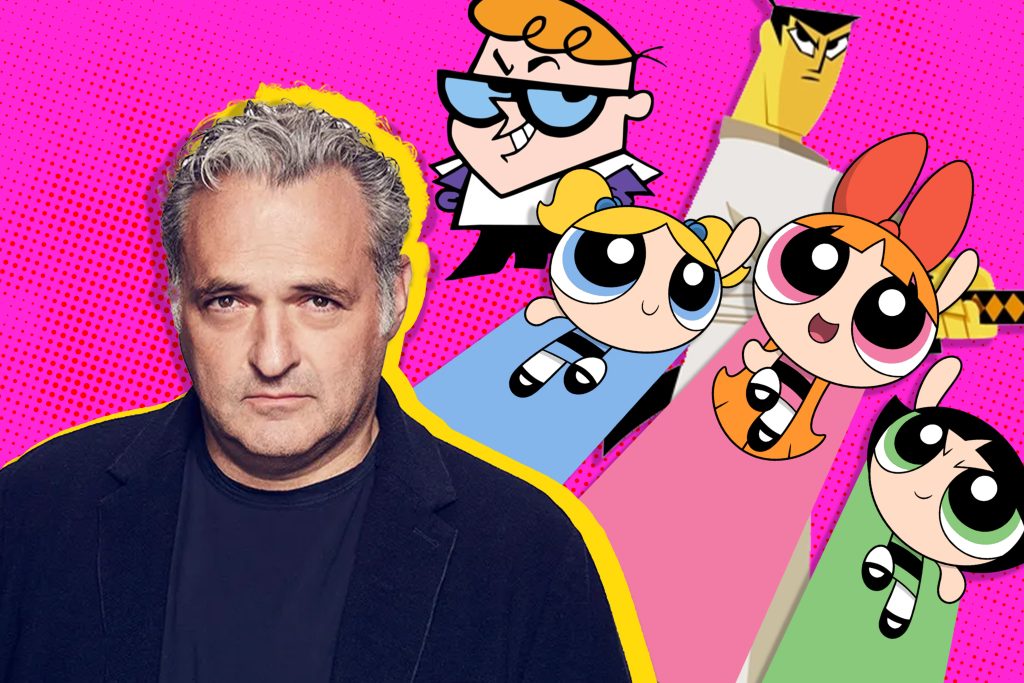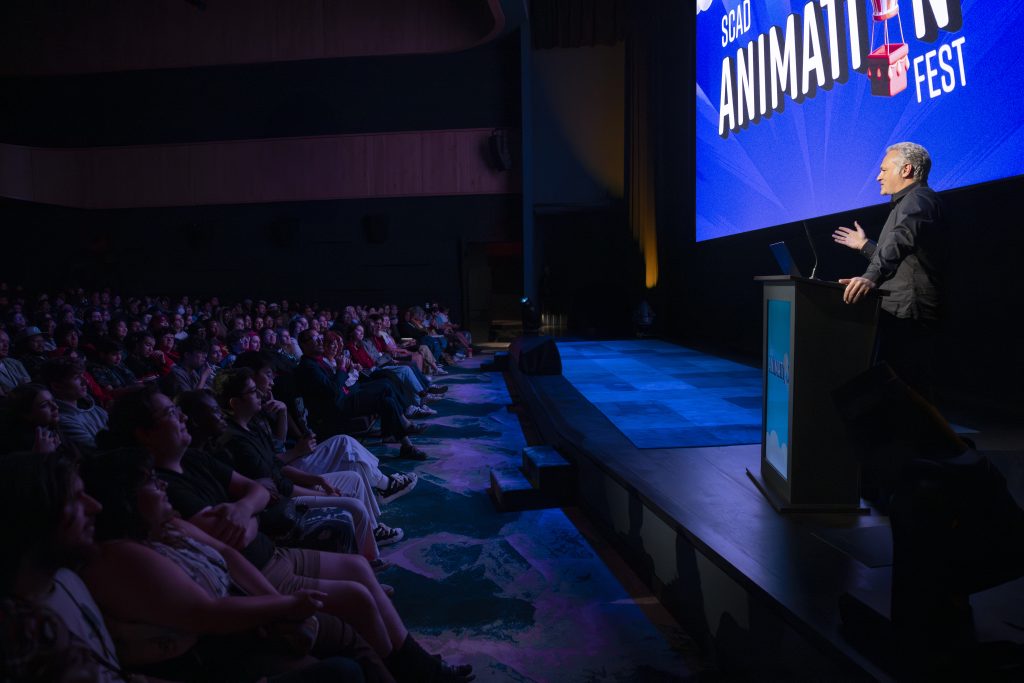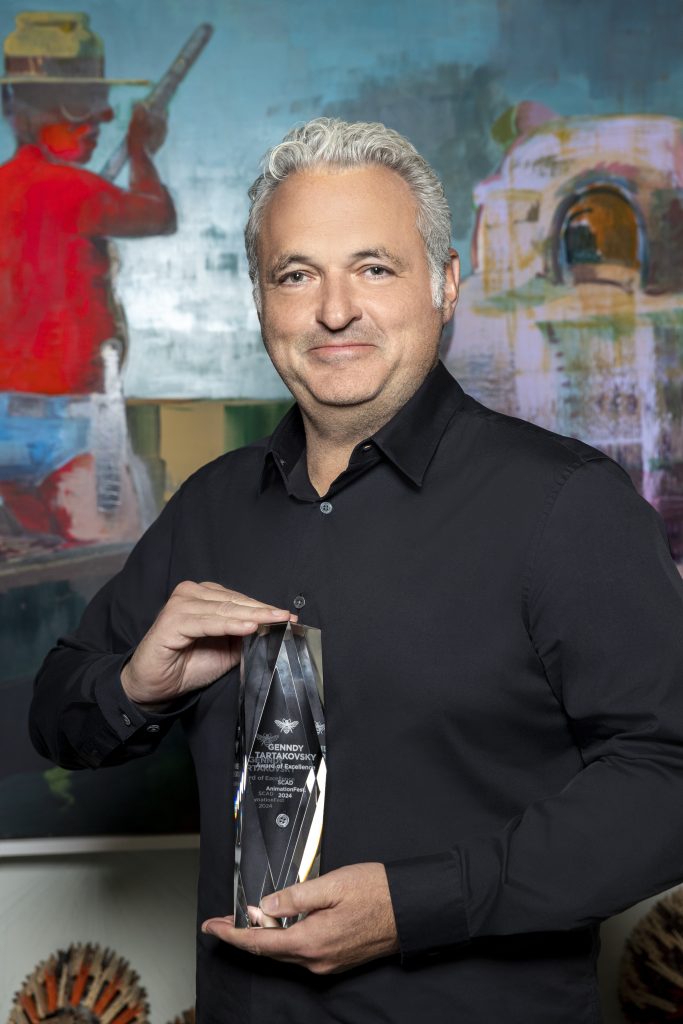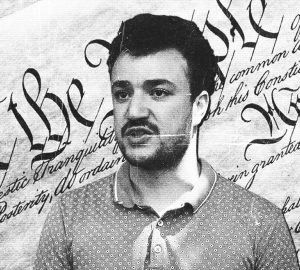
SCAD was lucky enough to honor animation legend, Genndy Tartakovsky. He’s responsible for creating some of the most iconic works like Dexter’s Laboratory, Powerpuff Girls, and Samurai Jack. During a two-hour keynote, he discussed his entire career offering advice and sharing his personal experiences. In his later career, he described working on feature-length films in the harsh entertainment industry and his future projects. However, as a young animation student who aspires to be a showrunner, I was more intrigued by his beginnings and how he got the opportunity to create some of the most influential cartoons of our time. He says it was all fate.
Genndy’s first introduction to animation was when he was six years old. Growing up in the USSR, the only animation available was a show about a chain-smoking wolf constantly chasing a cute rabbit. It was punchy and full of gags, referencing that Tom and Jerry style.
When his family immigrated to America, he was finally exposed to the full library of Western animation. Tom and Jerry, Hanna Barbera, Disney – it opened him to an entirely new way of experiencing this form of art. Tartakovsky in the presentation painted this beautiful scene of going to watch The Jungle Book as an older teenager. The theater was full of rowdy children but when the opening scene played all of the noise went away. Genndy was completely captivated by the immersive, beautifully detailed landscape. He was transported to that world saying, “All the sound went away”,
When Genndy originally entered college, he was an advertising major at Columbia College. However, he got the chance to take an elective animation class and remembered the sense of comfort that overtook him when he walked into the room. “The smell of the paper took me”. After that moment, he switched his major from advertising to film and TV, never looking back.
During this period, he took the chance to experiment and improve his craft. He was lucky enough to be gifted with an animation teacher who worked on Popeye and helped him on his initial journey. Genndy in his second year, created his first film which he admitted didn’t make much sense. It featured gremlins and a boy who loved a girl. It was a bit confusing and all over the place plot-wise, and execution-wise, there were half-finished scenes and wonky animation. But it was a start. There was something reassuring about a legend not having it all together – that it was ok to mess up.
When he visited his brother, he met his friend, Rob who eventually worked with him on Dexter. Rob had transferred to Columbia and told him about his dream to go to CalArts. Rob had been rejected multiple times but together they vowed to finally get in. Genndy made a box full of flipbooks and sent them to the school. With their acceptance letters in hand, he and Rob celebrated their collective accomplishment. He cites fate as the binding for all of these events.

Fate continued to look upon him fairly when there was a discrepancy with his financial aid. It had completely fallen through and after asking a friend, he was advised to plead his case to the head of the scholarship department. He gave an impassioned speech about his love for animation and how much this opportunity meant, ending that conversation with a full ride. It became very clear as a listener that he was destined to be in this position.
CalArts had the best of the best. He described that one of his classes was full of what would soon become Disney’s senior animators, and it showed. They were exceptionally talented while Genndy was still finding this stride. He had the very same thoughts I’ve had: Am I meant to be here? Am I good enough? Will I ever be good enough? But instead of letting his doubts get to him, he put his head down and got to work. He made connections, found his style in retro animation, and made the initial designs for his first big show. On the big screen, he showed sketches of Dee Dee from Dexter’s laboratory. Those sketches then transformed into a humorous short film of both Dee Dee and Dexter changing into various animals with the press of a button. It was that remarkable film that got him hired on Batman: The Animated Series.
At the very beginning of his career, he worked in the industry, firstly in Spain. While working on Batman, he learned how to adapt his style. He wasn’t used to the realistic, comic book style and had to work hard to expand his drawing capabilities. However, the company went under and stopped paying their animators. He didn’t want to be left stranded in a strange country so he moved on to the next gig.
He worked on commercials and then subsequently at Hanna Barbera where he continued developing his ideas. He describes sketching and working tirelessly on Dexter during company hours, covering it up with his actual work when an advisor would come by. Eventually, because of his connections in the industry, he was able to pitch his finalized Dexter short to Cartoon Network. The show was greenlit with the pilot receiving widespread acclaim and being nominated for an Emmy.
Genndy was a young director, thrust into this position. During this era of Dexter, he learned what it truly meant to be in this position. One of his partners pitched this hilarious idea to their entire team. It was so well-executed that Genndy wasn’t sure how to translate it into an episode. That was the moment he realized what it meant to be a director. It was all about translating an amazing performance or idea into animation – keeping that essence alive.
Samurai Jack was the culmination of Genndy’s style where he fully learned to push the boundaries and create the type of art he wanted without fear. He got smarter with stylization. Especially after Powerpuff Girls, he wanted no more thick, bold lines. He instead opted for more realistic but still stylized visuals. He wanted less dialogue, and more music and emotion. He showed the audience these beautiful thumbnails of backgrounds. They were breathtaking, full of detail and light – almost as if you could feel the atmosphere. The show went on to win an Emmy, beating out television giant, The Simpsons.
As a last note, Genndy left the audience with one last message. His entire career consisted of four main principles: relationships, hard work, luck, and point of view. All of these elements lead him to Cartoon Network, to make his first feature-length film, and to speak in front of us all. If we want to create and inspire similarly, we must heed his advice and take advantage of every moment. Do not leave any opportunity on the table, fight for your desires, and continue to grow as an artist.


























